Table of Contents
- Introduction
- Editor’s Choice
- LMS Market Size Statistics
- Regional Variations in the Adoption of LMS Statistics
- LMS Statistics by Software Adoption
- LMS Software Usage in Different Sectors Statistics
- LMS Statistics by User
- LMS Statistics By Personalized Learning Experience
- LMS Impact on Business and Academic Statistics
- LMS Statistics by Benefits
- LMS Statistics by Challenges in Adoption
- Recent Development
- Conclusion
- FAQs
Introduction
LMS Statistics: A Learning Management System, often abbreviated as LMS. It is a software application or platform designed to facilitate creating, managing, delivering, and evaluating educational content and training programs.
These systems have transformed how education and training are delivered and managed in the digital age. It is a centralized hub for organizing and delivering learning materials to learners or participants.
Learning Management Systems have become indispensable tools for educators, trainers, and organizations looking to deliver efficient, effective, and engaging learning experiences.
Their adaptability and data-driven capabilities make them a cornerstone of modern education and training, catering to many learners and industries.

Editor’s Choice
- The global Learning Management System (LMS) market, as of 2022, held a valuation of $16.1 billion. It is projected to experience substantial growth, reaching $61.8 billion by 2032.
- This anticipated growth reflects a CAGR of 14.8% over the forecast period.
- In the North American region, the LMS market is expected to grow remarkably. Becoming the fastest-growing segment and generating approximately $6.27 billion in revenue.
- Among the LMS buyer demographics, large companies that allocate significant resources to offer employees a standardized training environment represent 30% of the global market.
- Regarding primary users of LMS platforms, C-level executives account for 65%. While managers make up the remaining 35%, underscoring their pivotal roles in driving the adoption and utilization of these systems.
- In 2017, 77% of U.S. companies incorporated eLearning into their training initiatives. With 72% recognizing eLearning as a means to gain a competitive edge, highlighting its strategic importance.
- There are approximately 73.8 million users of Learning Management Systems (LMS).
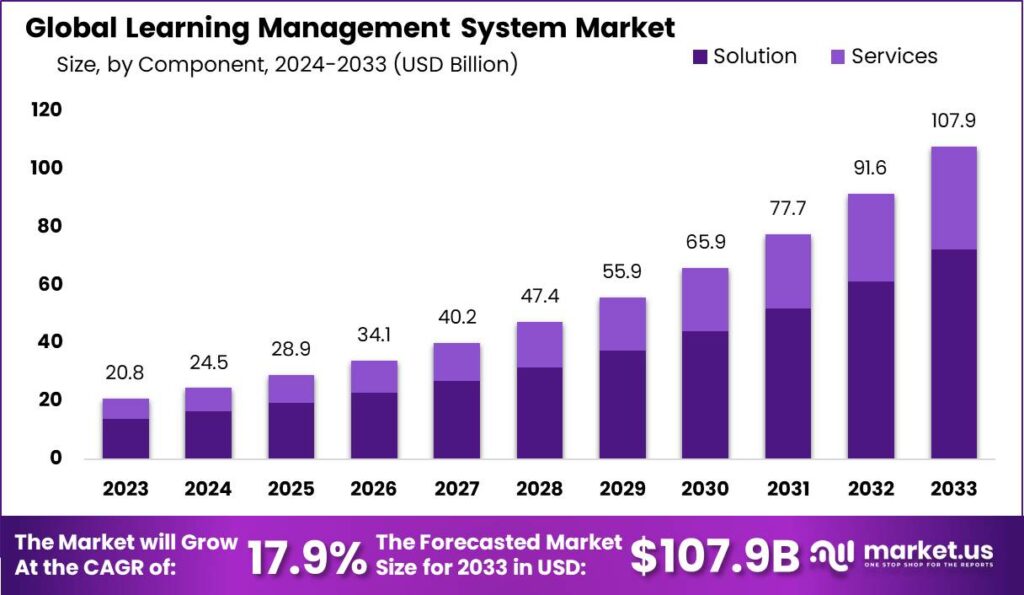
LMS Market Size Statistics
- Over the past decade, the Learning Management System (LMS) market has demonstrated remarkable growth and expansion, as evidenced by its CAGR of 18.4%.
- In 2022, the LMS market revenue stood at $16.1 billion, marking the starting point of a substantial upward trajectory.
- This growth trend continued unabated, with revenues surging to $18.5 billion in 2023 and $20.9 billion in 2024.
- By 2025, the LMS market had crossed the significant milestone of $24.8 billion. Underscoring its pivotal role in modern education and training.
- In the subsequent years, high growth is expected. With revenues reaching $28.9 billion in 2026, $32.6 billion in 2027, and $35.6 billion in 2028.
- As we look ahead, the LMS market shows no signs of slowing down. With revenue projections reaching $40.9 billion in 2029, $46.1 billion in 2030, $53.0 billion in 2031, and an impressive $61.8 billion in 2032.
- This exponential growth reflects the increasing adoption of LMS platforms across educational institutions and businesses. They are highlighting their pivotal role in shaping the future of learning and training.
(Source: MarketResearch.biz)
Regional Variations in the Adoption of LMS Statistics
North America
- The adoption of Learning Management Systems (LMS) within Learning and Development (L&D) departments in North America witnessed notable fluctuations over the five years from 2016 to 2020.
- In 2016, approximately 70% of L&D departments reported utilizing LMS. Indicating a strong presence and recognition of their value in facilitating training and educational initiatives.
- However, this figure experienced a slight dip in 2017. Declining to 67%, before showing a more significant drop to 56% in 2018. This decrease may have been influenced by various factors, including changing training methods or the availability of alternative technologies.
- Nonetheless, LMS made a resurgence in 2019, with 53% of respondents still employing these systems for learning and development purposes.
- By 2020, the adoption rate had bounced back to 70%, suggesting a renewed appreciation for LMS’s benefits to L&D departments in North America.
- These fluctuations in adoption rates underscore the dynamic nature of the LMS landscape, with organizations periodically reassessing their use of technology for training and education in response to evolving needs and trends.
(Source: Statista)
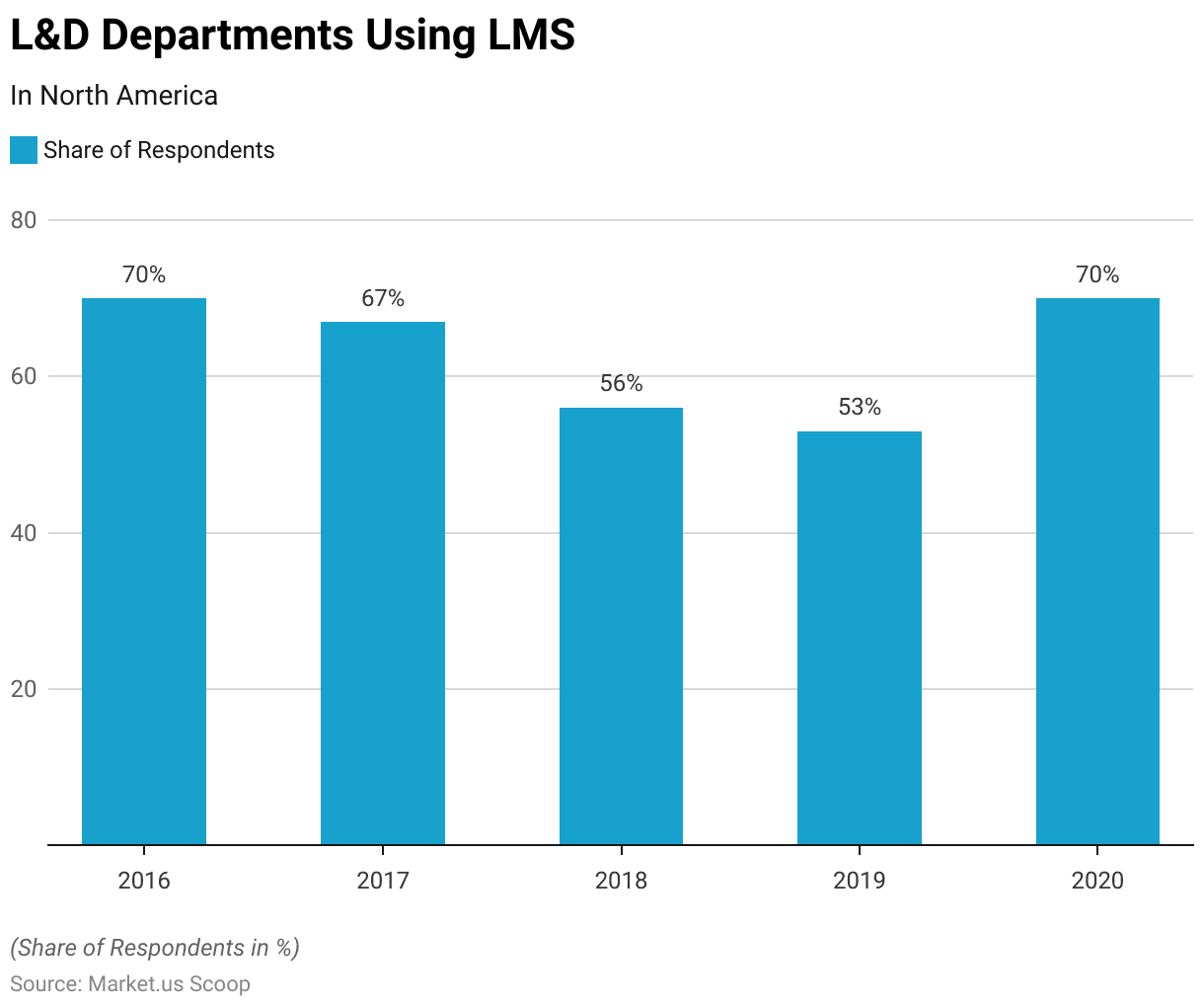
Latin America
- The growing use of mobile devices in Latin America has opened up numerous opportunities for the tech sector in the region.
- Consequently, from 2016 to 2020, the e-learning industry in Latin America experienced substantial growth, and it is projected to continue expanding at an annual growth rate of 14%.
- In 2016, the e-learning market in Latin America had a value of $2.1 billion, and this growth trajectory is anticipated to continue over the next five years.
- In terms of revenue, Latin America currently ranks as the fourth-largest ed-tech market globally.
- By 2023, it is estimated that the Latin American elearning market will generate an impressive $3 billion in sales.
- Furthermore, in 20 Latin American countries, nearly 12 million adults actively participate in online education.
- An example of this growth can be seen in Lingokids, a language learning platform, which experienced remarkable user increases of 489% in Argentina, 500% in Venezuela, and 425% in Brazil between 2016 and 2017.
(Source: Endeavor INSIGHT EdTech)
Europe
- Based on data from Eurostat, Finland boasts the highest proportion of people who have engaged in at least one form of online course, closely followed by the United Kingdom, Sweden, and Spain.
- Specifically, Finland leads the way, with 21% of its population participating in an online course covering various subjects.
- Following closely are the United Kingdom, with 19% of its population, Sweden with 18%, and Spain with 15%.
- Europe’s Learning Management System (LMS) sector witnessed substantial growth in 2020, with an expected Compound Annual Growth Rate (CAGR) of nearly 27%.
- The adoption of cloud-based LMS solutions has reached 12.5%, indicating a growing preference for cloud technology in managing learning processes.
- Looking ahead to 2022, Europe is poised to become the second-highest revenue generator in the global LMS market.
- Moreover, the LMS industry is experiencing notable growth in Eastern Europe, with an annual growth rate of 16.9%.
- This growth trend reflects the increasing significance of digital learning platforms in the continent’s Western and Eastern parts.
(Source: Eurostat)
Asia-Pacific
- In the upcoming years, the widespread adoption of Learning Management Systems (LMS) platforms is expected to gain momentum due to improvements in educational resources and the economic progress of emerging nations in the Asia Pacific region.
- Over the period from 2011 to the present, there has been a notable surge in LMS revenues in Asia, climbing from $5.2 billion to a substantial $11.5 billion.
- As we look forward to 2022, the LMS market in the Asia Pacific region is poised for remarkable growth, with a projected annual growth rate of 34.2%.
- What’s particularly noteworthy is that Asia boasts the highest elearning growth rate globally, experiencing a significant annual increase of 17.3%.
- This underscores the region’s growing commitment to digital learning and educational technology, which are becoming pivotal drivers in shaping the region’s educational landscape.
(Source: Internet Marketing with Blogs)
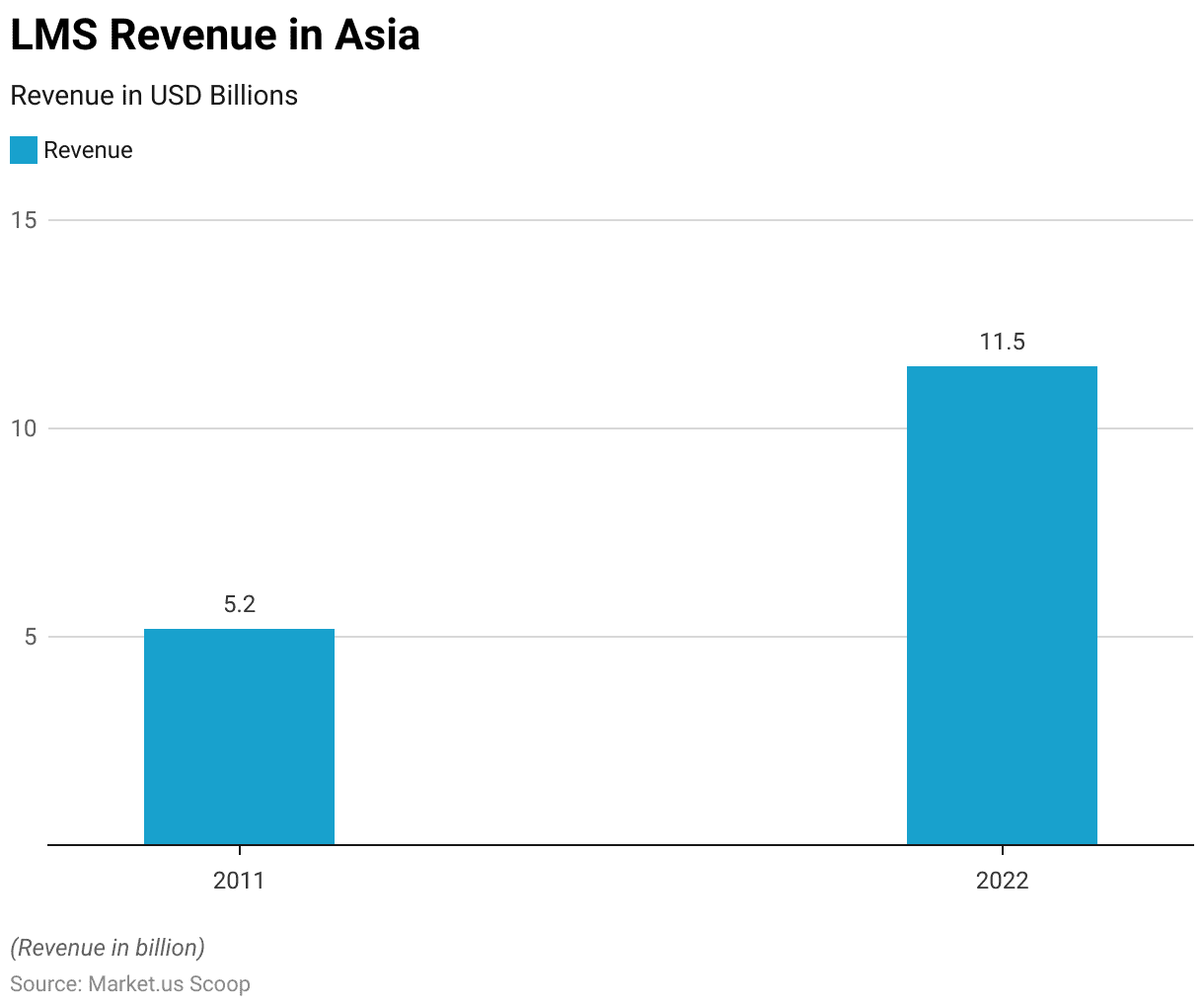
Africa
- Although LMS adoption in Africa has been on the rise, challenges persist that hinder the effective implementation of these systems.
- While online learning holds promise for enhancing the quality of education in Africa, obstacles like limited Internet connectivity, the availability of online learning materials, and insufficient teacher training continue to pose barriers to widespread LMS use across the continent.
- In Africa, the LMS sector is experiencing a steady annual growth rate of 15.2%.
- In 2016, the LMS industry in Africa generated sales of $512.7 million.
(Source: Internet Marketing with Blogs)
LMS Statistics by Software Adoption
- In 2017, 77% of U.S. companies incorporated eLearning into their training initiatives, with 72% recognizing eLearning as a means to gain a competitive edge, highlighting its strategic importance.
- Additionally, 67% of organizations embraced mobile learning, underscoring the increasing adoption of flexible and mobile-friendly learning solutions.
- Across North America, a considerable 70% of Learning and Development (L&D) departments harnessed the capabilities of a learning management system (LMS).
- Notably, 83% of L&D professionals reported executive support for employee learning, although only 27% noted active engagement from their CEOs as learning champions.
- In response to the COVID-19 pandemic, 66% of L&D professionals witnessed significant growth in their roles within their organizations.
- Furthermore, adopting Bring Your Own Device (BYOD) policies was prevalent, with 59% of organizations implementing them, leading to 67% of employees using personal devices for work-related tasks.
- Regarding learning preferences, 75% of employees favored video-based learning over text-based information.
- Likewise, 90% of students preferred eLearning over traditional classroom settings.
- Remarkably, 30% of global LMS buyers represented technology companies.
- The impact of COVID-19 has also prompted 66% of L&D professionals to anticipate increased spending on virtual-instructor-led training and online learning within their organizations.
- In higher education, 56% of online college students utilize smartphones or tablets for some coursework.
- In comparison, 81% of graduate students expressed an interest in or utilization of mobile devices for their online coursework.
- Leveraging the capabilities of LMS platforms, Google enrolled a substantial 80,000 of its employees in Udacity’s HTML5 course, showcasing the adaptability and scalability of these systems for large-scale learning initiatives.
(Source: eLearning Industry-2019, Extnsn Engine, Source: Mimeo-2020, LinkedIn-2020, EBN-2020, TechJury-2021, Designing Digitally-2019, eLearning Industry-2019, Wiley Education Services-2019)
LMS Software Usage in Different Sectors Statistics
- LMS software finds application across various sectors and industries, with varying degrees of adoption.
- The education sector leads in LMS software usage, with a substantial 21% utilization rate, underlining its significance in educational institutions.
- The technology sector closely follows at 12%, showcasing its commitment to digital learning and training.
- Manufacturing and healthcare sectors exhibit a notable 9% and 7% usage, respectively, emphasizing the value of LMS platforms in these fields.
- Consulting and software development companies share a 7% adoption rate, indicating their reliance on LMS for effective learning and development.
- Furthermore, real estate and nonprofit organizations have a 3% presence in the LMS landscape, highlighting their interest in these systems for training and educational purposes.
- These statistics reflect LMS software usage’s diverse and evolving nature across education, technology, manufacturing, healthcare, consulting, software development, real estate, and nonprofit sectors.
(Source: Office for National Statistics-2019)
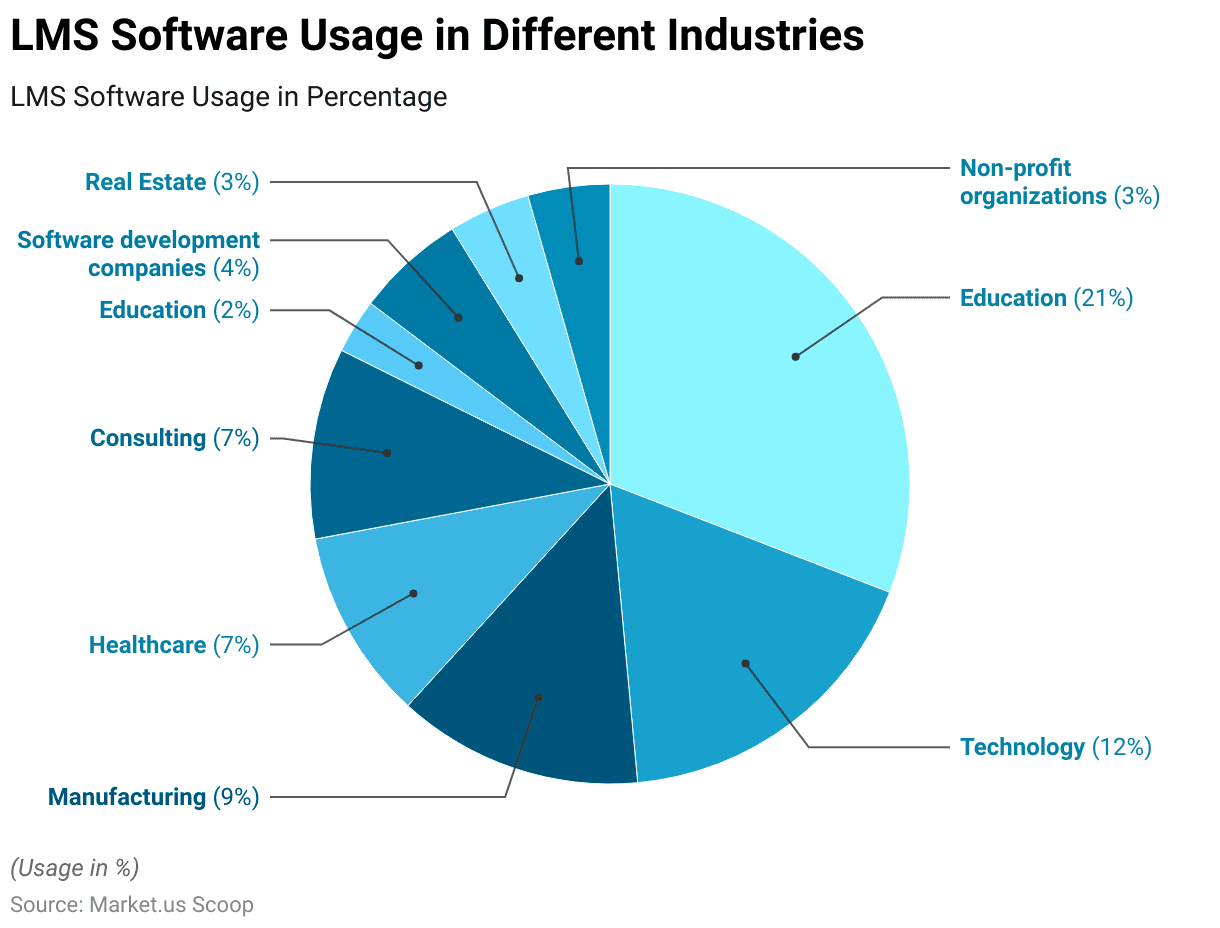
LMS Statistics by User
- There are approximately 73.8 million users of Learning Management Systems (LMS).
- Nearly 87% of these active users engage with web-based LMS programs.
- The primary participants in LMS platforms are corporate-level executives, constituting 65%, followed by managers at 35%.
- Among the LMS users, 37% are adults, while 28% fall into the young adult category.
- A notable 30% of LMS buyers represent well-established tech companies.
- Interestingly, 90% of students prefer online learning over traditional methods, and nearly half of them, approximately 49%, have enrolled in at least one online course.
- Around 4.6 million college students are pursuing their education through online classes.
(Source: Office for National Statistics-2019)
LMS Statistics By Personalized Learning Experience
- Teachers hold a spectrum of opinions regarding how they perceive personalized learning.
- A significant share of respondents, 25%, as a promising idea, with the potential and value in personalized learning approaches.
- Additionally, 21% of teachers consider it a transformative approach to the K-12 curriculum, indicating that it can reshape and enhance the educational experience.
- On the other hand, 11% perceive personalized learning as a fad, implying a certain skepticism about its long-term effectiveness.
- Some educators, 10% to be precise, have not yet included personalized learning on their radar, indicating a need for more awareness and understanding.
- Interestingly, 8% of respondents view personalized learning as a potential threat to public education, expressing concerns about its implications. These diverse perspectives among teachers underscore the complex and evolving nature of personalized learning in education.
(Source: Education Week)
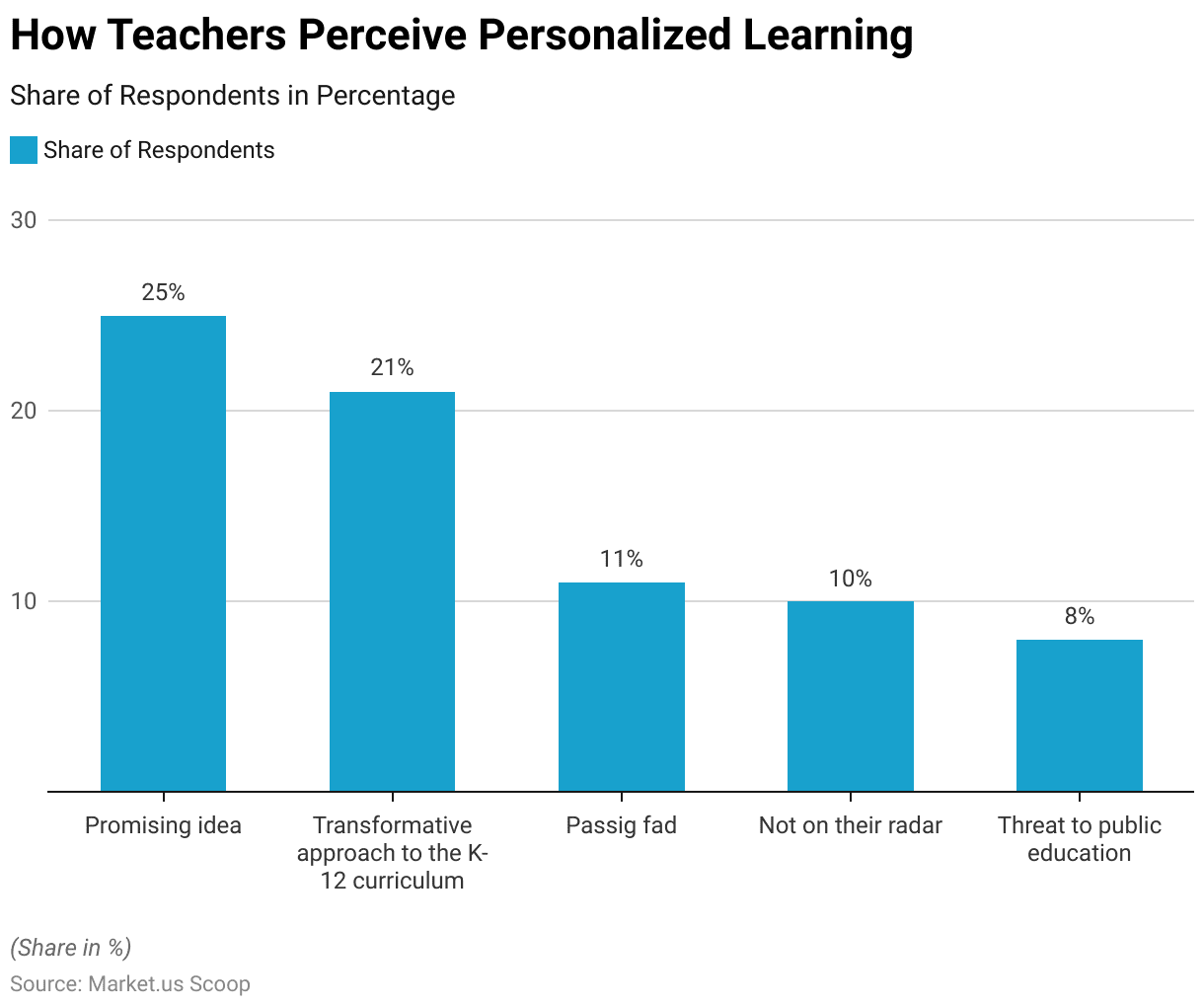
LMS Impact on Business and Academic Statistics
- Many Learning and Development (L&D) professionals, totaling 57%, anticipate an increase in their investment in online learning.
- Learning innovation has demonstrated the potential to yield a remarkable 9% improvement in organizational growth, transformation, profit, and productivity.
- The experiences of online students are also noteworthy, with 77% of those who transitioned from face-to-face classes reporting that their online learning experience is on par with or even superior to the traditional classroom setting.
- In 2019, many organizations are expected to adopt personalized training approaches.
- Companies that offer professional training and implement Learning Management Systems (LMS) can significantly improve employee retention rates by 92%.
- Self-paced training is preferred by 58% of employees.
- Remarkably, 41.7% of companies have realized substantial cost savings by embracing LMS for training.
- In 2018, although 93% of L&D professionals aimed to leverage LMS to enhance employee engagement, only 27% succeeded in doing so effectively.
- ELearning is proven to be significantly more time-efficient, requiring 40%-60% less employee time compared to instructor-led training, thereby reducing work disruption and eliminating the need for travel.
- Finally, employees utilizing LMS can achieve an impressive 93% improvement in training efficiency.
- These findings underscore the potential and advantages of online learning and the strategic use of LMS in various organizational contexts.
(Source: LinkedIn-2020, Emerald Works-2019, Wiley Education Services-2020, Forbes-2018, Matrix Blog-2017, eLearning Industry-2019, Cryptex-2019, Learning Technologies-2019, Dashe & Thomson, Matrix Blog-2017)
LMS Statistics by Benefits
- Allowing employees to learn at their preferred pace can lead to a notable increase in their performance, ranging from 15% to 25%.
- Compared to traditional classroom instruction, E-learning reduces learning time significantly by approximately 40% to 60% while enhancing information retention by 25% to 60%.
- According to a survey by the American Society for Training and Development, companies implementing a Comprehensive Training Program have reported impressive outcomes, including a remarkable 218% higher revenue and a 24% increase in profit margins.
- Furthermore, data published by CertifyMe.net has shed light on the fact that 72% of organizations credit e-learning with helping them stay agile and adaptable in the face of change, ultimately strengthening their competitive position in the market.
(Source: Hurix Digital, Shift eLearning, American Society for Training and Development, CertifyMe.net)
LMS Statistics by Challenges in Adoption
- 87% of millennials currently employed express dissatisfaction with their learning experiences, finding them uninteresting and lacking relevance.
- Meanwhile, 40% of millennials prefer learning to enhance their presentation skills and unlock their creative thinking abilities.
- Regarding seeking information and learning resources, 40% of employees turn to Google for answers before approaching a colleague or utilizing the company’s learning technology. This suggests that the current learning platform may not fully meet the immediate needs of learners.
- Within HR and management, 80% struggle to bridge the internal skills gap, while 69% report declining productivity levels.
- Moreover, 67% admit to falling short of their financial and performance objectives. Highlighting organizations’ challenges in meeting their goals and maintaining optimal productivity.
Recent Development
Acquisitions and Mergers:
- Cornerstone OnDemand acquires Saba Software: In early 2023, Cornerstone OnDemand completed its acquisition of Saba Software for $1.4 billion. This merger aims to expand Cornerstone’s capabilities in talent management and learning solutions, enhancing its LMS offerings.
- Blackboard merges with Anthology: Blackboard and Anthology merged in mid-2023, creating one of the largest EdTech companies. This merger is expected to provide a comprehensive suite of LMS and student information systems, improving educational technology services.
New Product Launches:
- Moodle Workplace: Moodle introduced Moodle Workplace in late 2023, a specialized LMS designed for corporate training and professional development. This platform offers advanced features like customizable dashboards, multi-tenancy, and comprehensive reporting tools.
- Canvas LMS Updates: In early 2024, Instructure launched significant updates to its Canvas LMS, including enhanced mobile functionality. Improved analytics, and new collaboration tools, aiming to provide a more seamless and interactive learning experience.
Funding:
- TalentLMS raises $50 million: TalentLMS, a cloud-based learning platform, secured $50 million in a funding round in 2023 to expand its product offerings and scale its operations globally, focusing on improving user experience and platform capabilities.
- Schoology secures $40 million: In early 2024, Schoology raised $40 million to enhance its LMS platform, particularly its K-12 offerings, by integrating more advanced features and expanding its market presence.
Technological Advancements:
- AI and Machine Learning Integration: LMS platforms are increasingly incorporating AI and machine learning to provide personalized learning paths, automate administrative tasks, and enhance student engagement through adaptive learning technologies.
- Virtual Reality (VR) and Augmented Reality (AR): Advances in VR and AR are being integrated into LMS platforms, offering immersive learning experiences that enhance student understanding and engagement through interactive simulations and virtual environments.
Market Dynamics:
- Growth in LMS Market: The global LMS market is projected to grow at a CAGR of 20% from 2023 to 2028, driven by the increasing adoption of online learning, corporate training needs, and advancements in educational technology.
- Increased Adoption in Corporate Training: Companies are increasingly adopting LMS platforms for employee training and development, recognizing the benefits of scalable, flexible, and efficient learning solutions to enhance workforce skills.
Regulatory and Strategic Developments:
- Data Privacy Regulations: LMS providers are enhancing their platforms to comply with data privacy regulations such as GDPR and CCPA, ensuring the protection of student and employee data and maintaining trust in their services.
- Industry Standards: Efforts are being made to establish industry standards for LMS platforms to ensure interoperability, security, and accessibility, fostering a more cohesive and reliable educational technology ecosystem.
Research and Development:
- Advanced Analytics and Reporting: R&D efforts are focusing on developing advanced analytics and reporting tools within LMS platforms to provide educators and administrators with deeper insights into learner progress, engagement, and outcomes.
- Gamification in LMS: Researchers are exploring the use of gamification in LMS platforms to increase student motivation and engagement, incorporating game-based elements such as badges, leaderboards, and interactive challenges.
Conclusion
LMS Statistics – Over the years, the (LMS) has maintained a steady level of user engagement, with frequent logins and course enrollments indicating sustained interest.
Courses with high completion rates and popular content have emerged as strengths, while assessment data and user feedback provide opportunities for improvement.
Demographic insights, technology trends, and performance metrics inform future considerations such as content enhancement, personalization, mobile optimization, performance improvements, and ongoing compliance with data security measures.
FAQs
An LMS, or Learning Management System, is a software application that delivers, manages, and tracks online training and educational courses. It provides a centralized platform for instructors and learners to access course content, assessments, and communication tools.
LMS platforms streamline the administration of courses, improve accessibility, enable self-paced learning, and facilitate tracking and reporting of learner progress. They are invaluable for scaling training programs and ensuring consistency in content delivery.
Standard LMS features include content management, user management, assessment and quiz tools, progress tracking, reporting and analytics, communication tools (e.g., discussion forums, messaging), and integration with other software.
Users typically access an LMS through a web browser on their computer or mobile device. Some LMS platforms offer dedicated mobile apps for a more seamless mobile experience.
LMS platforms increasingly incorporate artificial intelligence (AI) for personalized learning experiences, predictive analytics for learner success, and adaptive content delivery. These trends aim to make learning more tailored and effective.
Discuss your needs with our analyst
Please share your requirements with more details so our analyst can check if they can solve your problem(s)



